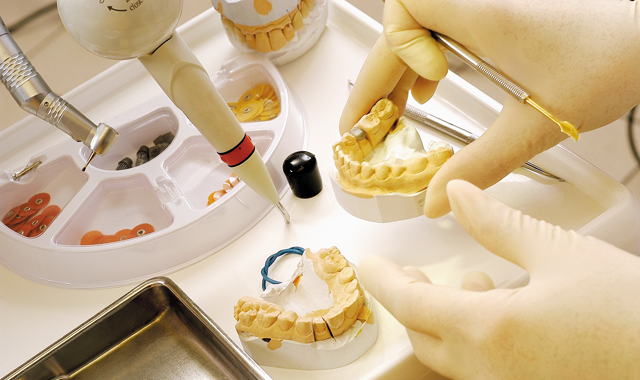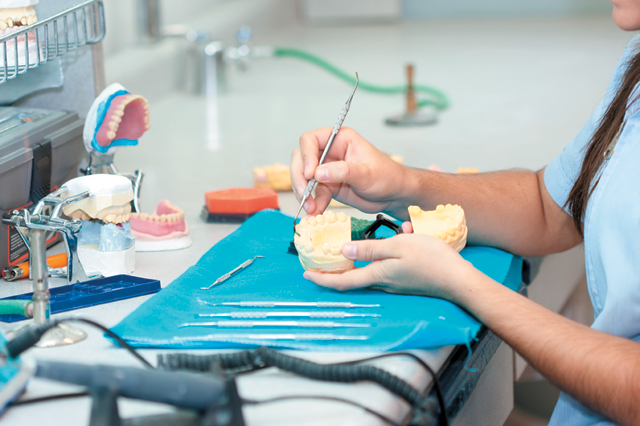10 Ways To Make a Great Impression
It’s critical to patient outcomes to have an accurate impression. Here’s what you need to know about both digital impression systems and traditional methods.

Dental impressions are vital to many dental procedures. From crowns and bridges to implants, from orthodontics to prosthetics, cosmetic dentistry and more, making a great impression matters.
Although dental impressions are a significant part of a dental practice, they are also a significant source of frustration. Perfection is both essential and elusive. Many factors will affect the outcome, and many of them are out of the dental professional's control.
Everyone has his or her secrets for taking the best impression, whether using a digital or traditional method. We talked to clinicians, a dental assistant and industry experts to learn a few. Here's what our experts told us.
"What is a good impression? A good impression is going to be a technique that gives you the perfect negative impression of the teeth, the gum and the sulcus," says Dr. Eric Caron, a prosthodontist with Dental Wings. " Not only the tooth surface. We need a full copy."
Continue to the next page to see the top 10 ways to guarantee a good impression.
1. Expand your time with tissue management.
Dr. Marc Geissberger, Professor and Chair of the Department of Integrated Reconstructive Dental Sciences at University of the Pacific, asserts that "proper tissue management is essential." Although there are many techniques used for tissue management, there are some absolutes, according to Dr. Geissberger. "The field must be free of contaminants and must not bleed. So number one is focusing a little more time and attention, not so much to the actual squirting of the impression material, but to the tissue management during the procedure."
Dr. Caron agrees. "So the difficulty of the procedure is not related to the use of the material because a dentist with a high skill level is going to handle any material. It's not the material that is responsible; it's how you manage your tissue. It's how you're going to control the saliva and be sure nothing is going to push your material away from the side of the tooth.
2. Two words: Tissue retraction.
Tissue retraction is key to taking a great impression. The dual-cord or double-cord impressions technique is an excellent way to retract the gingival tissue and allow for adequate access into the sulcus. "Retraction and isolation are the two key points. If you have that, then you're going to have a good impression," Tija Hunter, dental assistant and vice president of the American Dental Assistants Association, says.
Dr. Caron explains: "When you're going to extract your impression after the polymerization, it needs to have a minimum of material. If you do not have that minimum, and you remove your tray, the material is going to break, and it's going impair the quality of your restoration. So we need to do a certain amount of retraction. Some studies say that every time you take a regular impression, you're going to add 0.3 mm of gum retraction, even if you're the best, because you traumatize your gum. You need that retraction to be sure you have the space for your material."
"A lot of times dentists are looking for the cheapest stuff out there, not necessarily quality," says Dr. Tim Bizga of Parma, Ohio. "But impression materials are not all created equal. There are impression materials you pay more for because they're better. It's not necessarily because a big company label is going on it or whatnot."
3. Pick a material and stick with it.
3Ms Imprint 4 VPS impression material is formulated to help optimize the impression procedure with innovative chemistry that lets dentists save time and get accurate results.

Dr. Caron believes you should choose a material, become a master of it and then stick with it. "You don't want to change the material each time one comes out and have a new learning curve every six months," he says. "I need to know how that material is going to flow in my syringe. When you stick to something, and you get success, you do not want to change; you don't want better than that. New material is not what's going to be the secret. It's going to be how you work and how you control your tissue."
John Aguirre, regional product line manager for Carestream Dental's CS Solutions CAD/CAM portfolio, agrees. He believes that every person is unique and has their tricks for getting the results he or she wants from impressions. Whether using a digital scanner, polyvinyl or alginate, honing your skills for what works best for you is essential to capturing a good impression. "It's really old school, but people took impressions with alginate no problem because they'd honed their technique so well, they could just make it work," Aguirre says.
4. Switch focus from the margin to the sulcus.
When dentists take an impression, they concentrate on the margin. Dr. Geissberger says to forget that and instead focus on capturing the sulcus: "If they focus on taking an impression of the sulcus rather than the margin, by default they capture the margin because they're below the margin."
5. Use the Force.
Dr. Geissberger, who is also in private practice in Greenbrae, California, says when people take impressions they tend to seat the tray gently. However, a quick, forceful motion is far better to move impression material where you need it, particularly down in the sulcus. "Tell the patient, ‘When I seat this impression tray, I'm going to push quickly. It won't hurt, but it's going to be forceful and fast,'" he suggests.
6. Always work distal and mesial in two paths.
When taking traditional impressions, one must consider the flow of gravity. Since the patient is lying on his or her back, the material will drip, following the pull of gravity. Dr. Geissberger wants dental professionals to work with gravity, not against it. "Start your impression from the distal lingual corner of the tooth working towards the mesial lingual, capturing all of the lingual margins first," he advises. "Then lift the syringe out, rotate it 180 degrees and go to the distal buccal.
"From there, you capture all of the buccal margins working mesially to the mesial buccal. Then you cover the occlusal feature tray, and you're good to go," he says. "By starting with the distal, the material is always dripping away from you, which allows you to see the entire procedure. If you inadvertently started from the mesial, the material would start dripping back and obscure your view of capturing the margins.
7. Bleed it thoroughly.
Bleeding from the gums is a problem, but not bleeding the material cartridge and the tip is, too. Bleeding the cartridge ensures the material enjoys a proper mix so it sets up after you seat the tray. Hunter says she sees that mistake with new dental assistants.
"If you're in too big of a hurry, and you're not bleeding it, that first little bit that doesn't get mixed is probably going to be right where you need your impression the most. And that always presents a problem. So if you're not bleeding your syringes before you put your material in the tray, that's a huge mistake," she says, "And gosh, talk about a mess. It's hard to clean up!
8. Focus on the finishing line.
Carestream Dental CS 3600 intraoral scanner is designed to make the digital impression workflow fast and easy.

When you take an impression, you have to focus on the finishing line of your future restoration, explains Dr. Caron, who notes that poor impressions are responsible for the black lines that are sometimes visible on restorations. "That crown is not sitting perfectly, and the bacteria comes in, so the gum retracts and you see the lid of the final restoration," he says. "You need to be sure the finish of the line is below the gum, making sure that we do not see the future crown and the line between the future crown and the tooth itself."
This requires extra attention to the tissue prep, particularly to bleeding gums. "If blood comes when you inject your material," Dr. Caron notes, "even if the polymerization of the material is possible, the pressure that makes the blood come inside of the impression is going to push away your material, and you're going to have some bad definition of your finishing line."
Some professionals believe digital tools might help the final result."Digital is just the way to go. I talk about that all the time," Hunter says. "I know there are so many people out there still taking impressions, and I just want to know why. The digital impression is much more precise and accurate. It takes out human error. You don't get a void. You don't get tearing of the impression material where you're taking it out. It takes out all that human error and gives you a much better product."
9. Talk to the lab.
There are many implant manufacturers-both big and small-and manufacturers can decide to make a proprietary scan body type for digital impression scanners. Therefore, in an implant workflow, communication is critical because the doctor must know what design software their lab uses. "Every time a doctor starts asking me about the impression workflow, I say ‘Talk to your lab. Find out what they use,'" Aguirre says.
10. Help the patient help you.
One of the biggest challenges any dental professional has no matter his or her skill level taking impressions is managing the patient during the uncomfortable procedure. Dr. Geissberger says most clinicians give patients the wrong advice.
"They tell patients, ‘Don't move your tongue.' What you have to tell patients prior to the impression at the moment you're about to squirt the material is ‘Do not swallow.' And you keep repeating that to patients."
Dr. Geissberger tells his patients how swallowing lifts the saliva from the floor of their mouth into the impression material or scanning area and that then they will have to take the impression again. "Now if you don't remind patients not to swallow, inevitably, they're going to feel gaggy," he notes. "They're trying their best, but they will swallow during the impression and flood the field with moisture."
Finally, did you know ...

... Most patients prefer digital impressions?
"We did a survey years ago with our patients about the digital experience. When we asked the question, ‘Would you prefer this to a conventional impression?', the results were 98 percent favoring a digital impression," says Dr. Geissberger.
... There is less of a learning curve with digital impressions?
"We prefer digital because it is so much easier of a workflow and there is less of a learning curve when it comes to digital because you're capturing images rather than trying to squirt that material on an area that sometimes you can't really see well," says Aguirre.
... Your practice makes a better impression on patients with digital impressions?
"We like knowing that our healthcare is up-to-date with technology, too. When patients see that you have the technology to do this, which makes it more convenient for them, they're all over it," says Hunter.
ACTIVA BioACTIVE Bulk Flow Marks Pulpdent’s First Major Product Release in 4 Years
December 12th 2024Next-generation bulk-fill dental restorative raises the standard of care for bulk-fill procedures by providing natural remineralization support, while also overcoming current bulk-fill limitations.